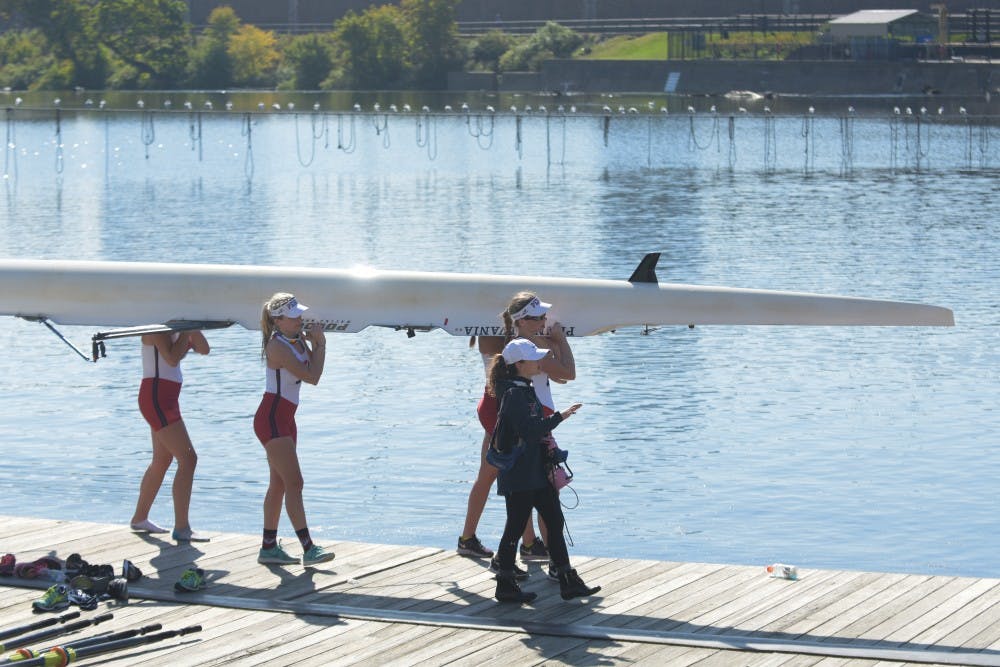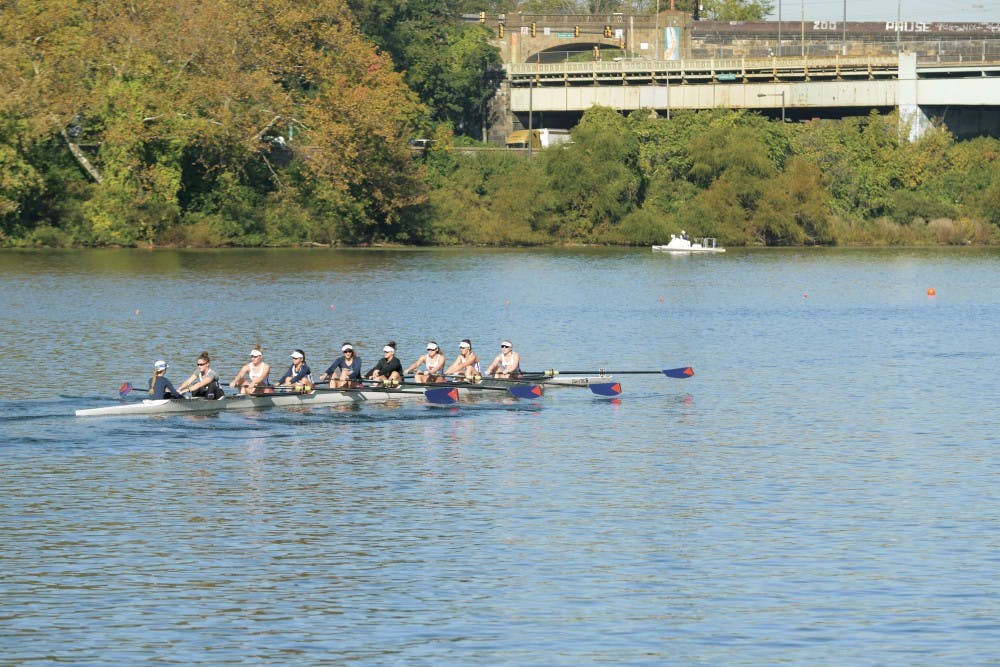
It has been nearly two decades since the Schuylkill was last dredged. Crew teams across Philadelphia, including those at Penn, may soon be forced off the river as a result of this. (File Photo)
Rowing teams who use the Schuylkill River as a training location might soon be forced off the river if it is not cleared of silt.
As the Temple Men’s Crew head coach and a member of the Fairmount Rowing Association, Brian Perkins spends much of his time on the Schuylkill River's boathouse row. He explained that the buildup of silt in the river has made it increasingly difficult for rowing teams to use the iconic Philadelphia waterway.
“On boathouse row over the summer, it’s been so shallow you can damage equipment just by putting boats in the river,” Perkins said. “And in some places down there, it’s about maybe six [or] seven inches of water, so when you’re cruising out, literally your oars are in mud.”
Perkins said he thinks that if the Schuylkill is to remain a prominent river for racing in the Philadelphia area, it needs to undergo dredging — a process by which silt deposits are excavated from the bottom of a body of water to make it more navigable. A project of this magnitude could cost an estimated $4.5 million, according to head of the Schuylkill Navy’s River Restoration Committee Paul Laskow, and rowers have turned toward Penn for a helping hand.
Over the past four years, the Schuylkill Navy — an advocacy group for the maintenance of its namesake — has lobbied the state and federal government to fund the river's first dredging since 1999. But after Harrisburg and Washington repeatedly ignored its overtures, the Schuylkill Navy has deemed it necessary to search for alternative avenues of funding, said Laskow — namely the city’s major universities.
Laskow explained that universities like Penn have extensive donor bases and financial offices that the Schuylkill Navy lacks, adding that he hopes collaboration with such universities will help the group to raise enough money to dredge the river in the absence of government funding.
“The 'City Six' [Penn, Drexel, Temple, Jefferson, St. Joseph’s, and La Salle] have substantial development staff; some people may joke that universities are developmental offices with small academic programs on the side,” Laskow said. “They have professionals who know how to ask people for money and where to look.”
Laskow said that the Schuylkill Navy does not necessarily expect significant help from the local universities, but the group still plans to try.
“Even if the answers from the universities aren’t overwhelming, we still have to ask them,” Laskow said, noting that, with their large rowing programs, the universities are the major stakeholders for the project.
If the Schuylkill’s condition remains unchanged, Laskow predicts that some rowing teams may be forced to use shallower rowing lanes and would thus have a disadvantage. To prepare for this increasingly likely possibility, Laskow said that some clubs, such as the Philadelphia Scholastic Rowing Association, have already begun moving races off the Schuylkill and out of Philadelphia.

The rowing team practicing on the Schuylkill River. (File Photo)
“[Rowing clubs] can’t wait until people vote with their feet, and not come to regattas because they don’t feel they have a fair venue,” Laskow said. “So those decisions will be made by the regattas early in 2019.”
Laskow added that with regattas leaving Philadelphia, the city will lose an estimated $25 million of economic activity that these events generate.
Perkins agreed with Laskow’s prediction about races being moved from the Schuylkill. He added that there are potential risks to current rowers and their equipment, with the possibility of debris getting caught in relatively shallow water.
“You have your $60,000 boat with nine athletes in it trying to dodge a tree branch that’s sticking out just below the surface depending on what the water level’s doing, and that can create a safety issue,” Perkins said.
Howard Neukrug is the former CEO of the Philadelphia Water Department and the current director of The Water Center at Penn, an organization that studies the sustainability of urban water resources. He said that he trusts the conclusions reached by the Schuylkill Navy and the Temple crew coach.
“In terms of the issues of flows on the Schuylkill and levels of depth and sediment build-up, clearly there’s no one better than people who are regularly out on the Schuylkill to judge what’s going on,” Neukrug said.
Penn crew, who have been on the water since the second week of school, also number among those who have experienced the deteriorating river conditions firsthand.
In early September, Penn Boathouse Director Andrew Blum relayed problems with the river to the Schuylkill Navy, according to an email from Schuylkill Navy Vice-Commodore Beatrice Mueller. Blum reportedly told the Schuylkill Navy that crew teams are having difficulty accessing coach safety launches and using portions of the Penn docks.
When contacted by The Daily Pennsylvanian, Andrew Blum deferred comment to the Athletic Department’s Strategic Communications Director Kevin Bonner.
The Daily Pennsylvanian reached out to Bonner for comment on Sept. 10. He had not responded to multiple requests for comment at the time of print.
Although Laskow said Penn has thus far been supportive of the Schuylkill Navy’s lobbying efforts for dredging appropriations, it remains unclear whether the University will be receptive to the Schuylkill Navy’s appeals for more direct fundraising support.
Across the city, La Salle University is in communication with the city and other universities to reach "an actionable solution" for the Schuylkill, according to an email to the DP from La Salle Chief Marketing & Communications Officer Jaine Lucas.
For Laskow, an essential part of such a solution is to create a plan to fund future dredging projects. He said the Schuylkill Navy is organizing a program with the city and local regattas to fund a dredging every decade. In the meantime, the group will focus on the $4.5 million needed for the initial project.
“You have to recognize a civic obligation for supporting this civic asset,” Laskow said. “And in Philadelphia, to let this slip away — it would just be a real tragedy.”
The Daily Pennsylvanian is an independent, student-run newspaper. Please consider making a donation to support the coverage that shapes the University. Your generosity ensures a future of strong journalism at Penn.
Donate






